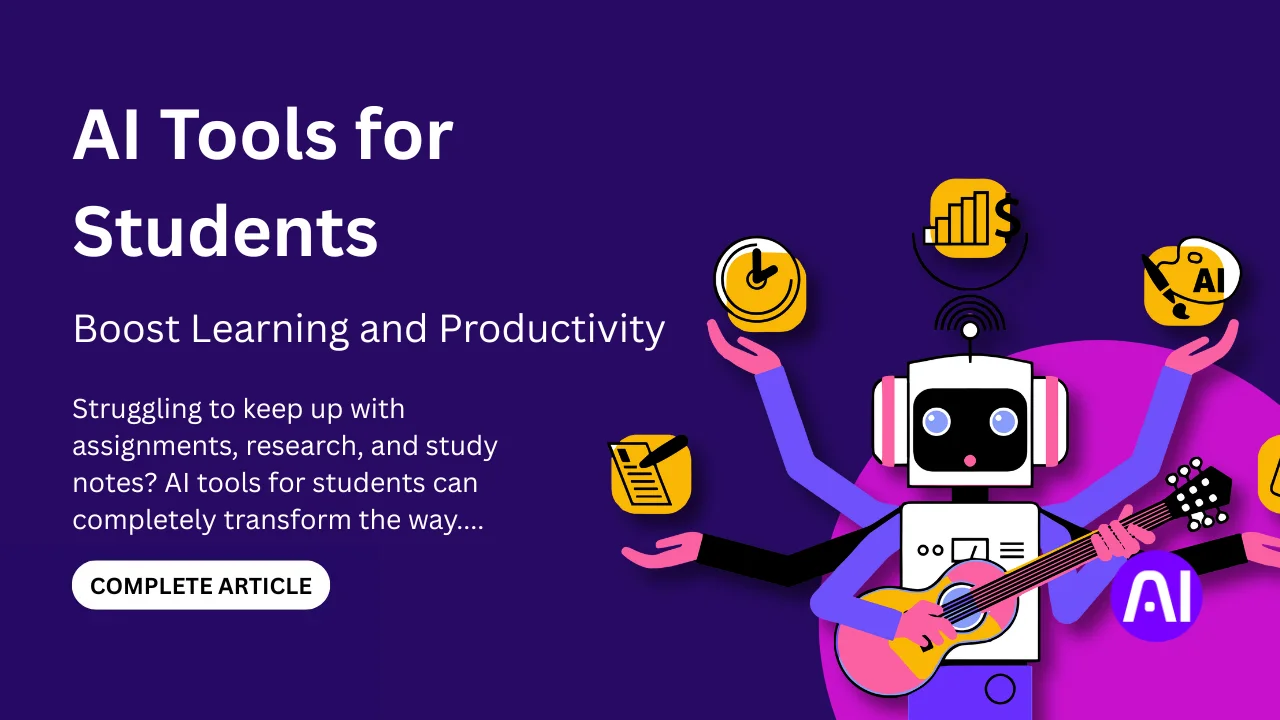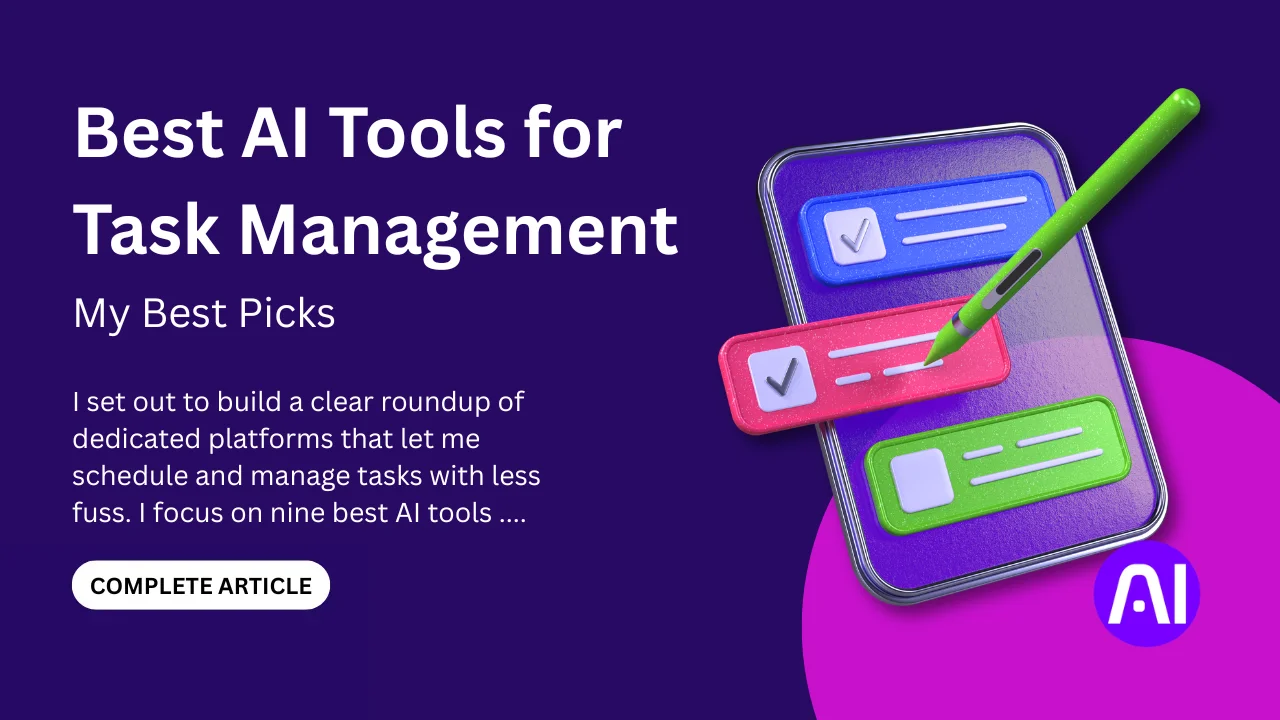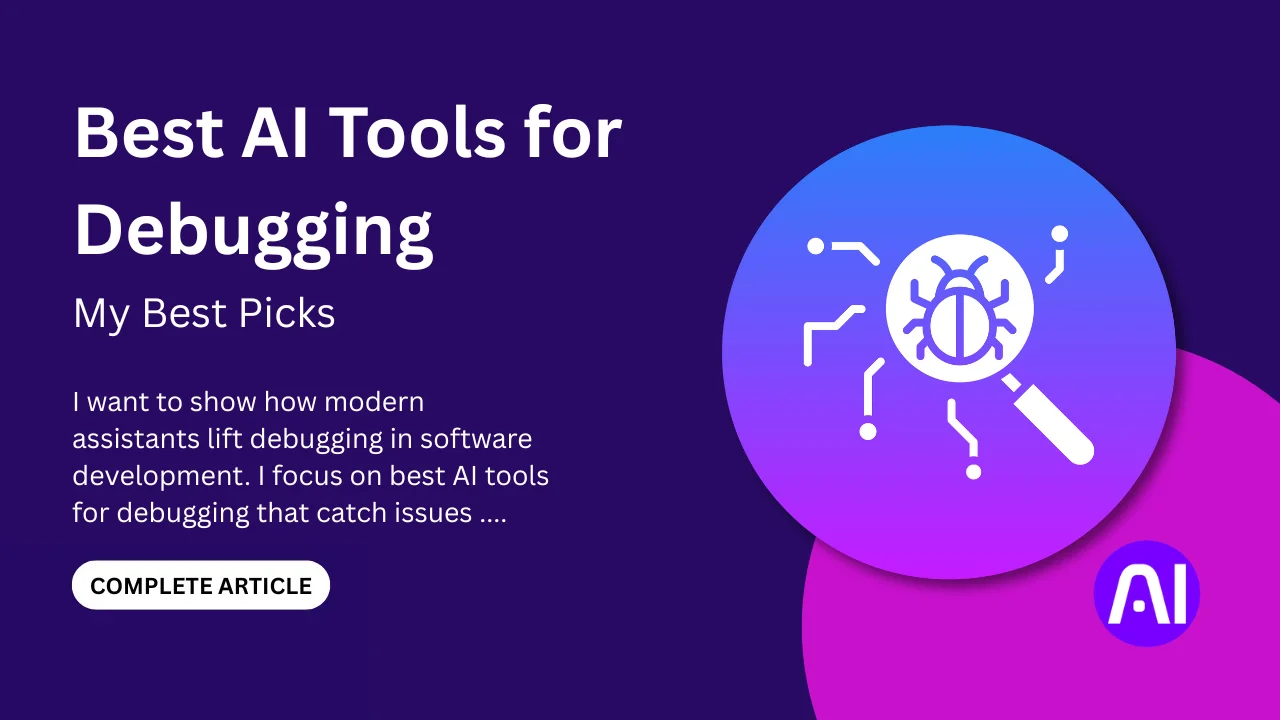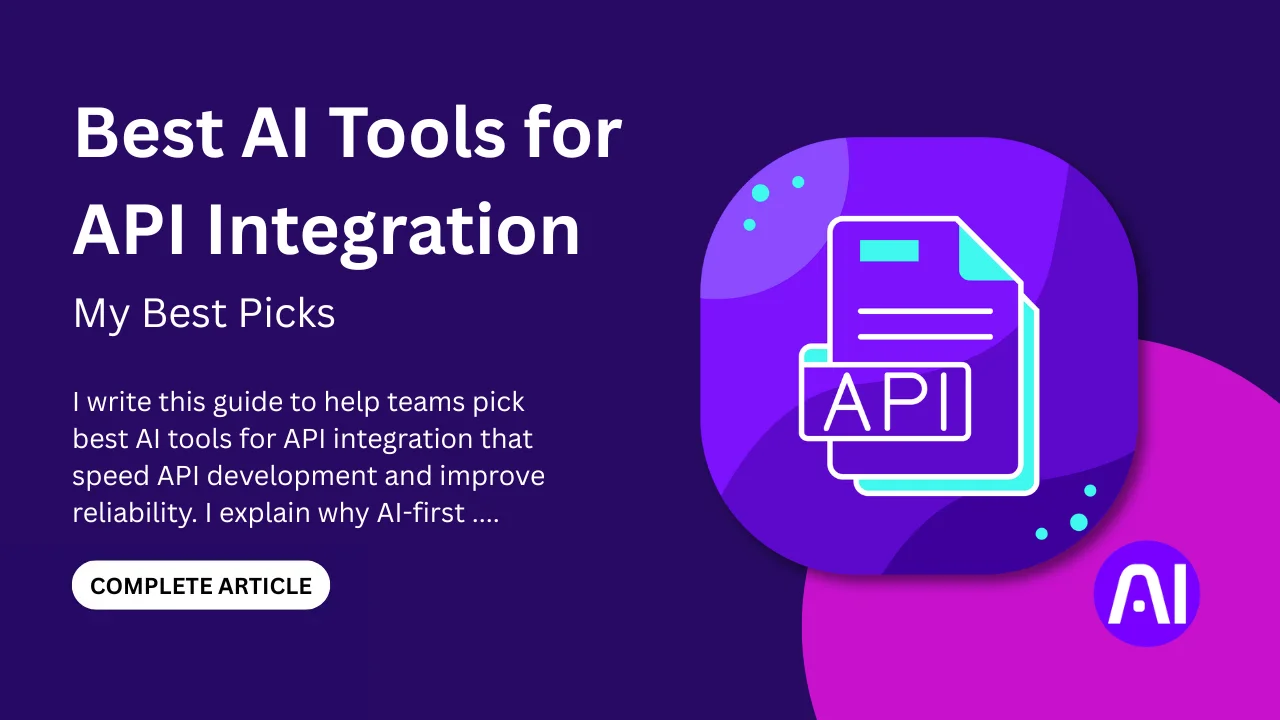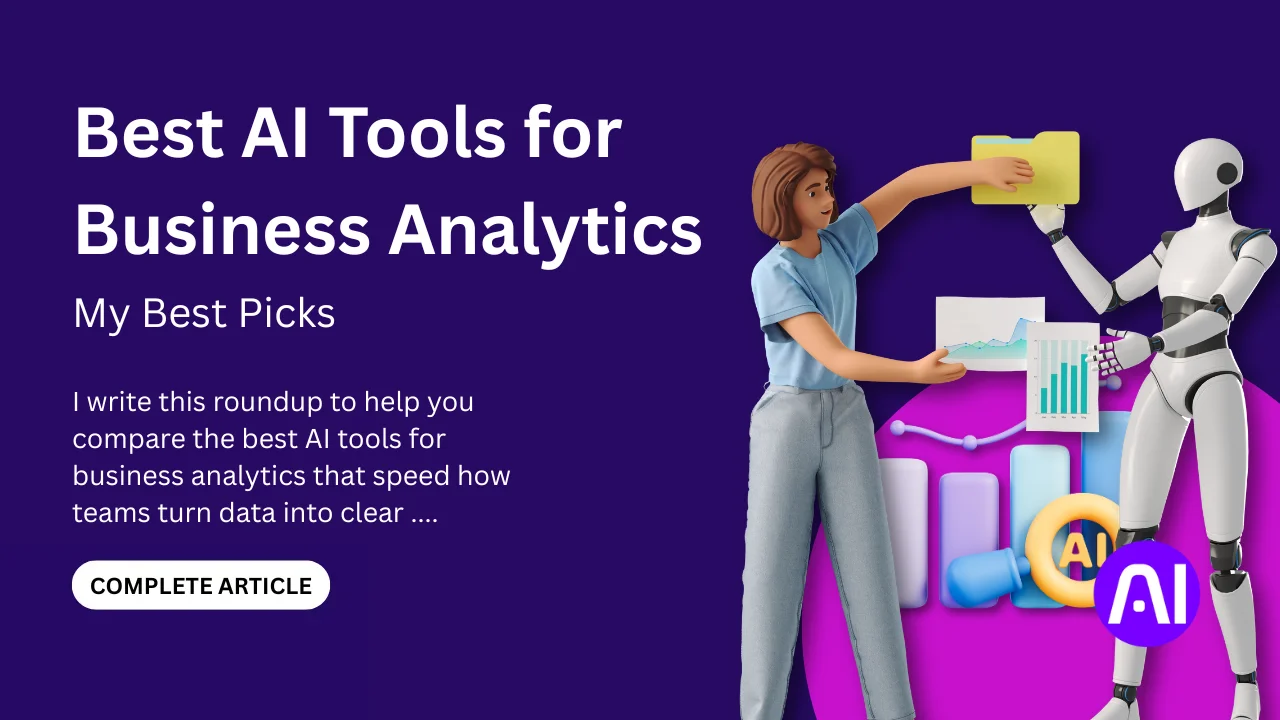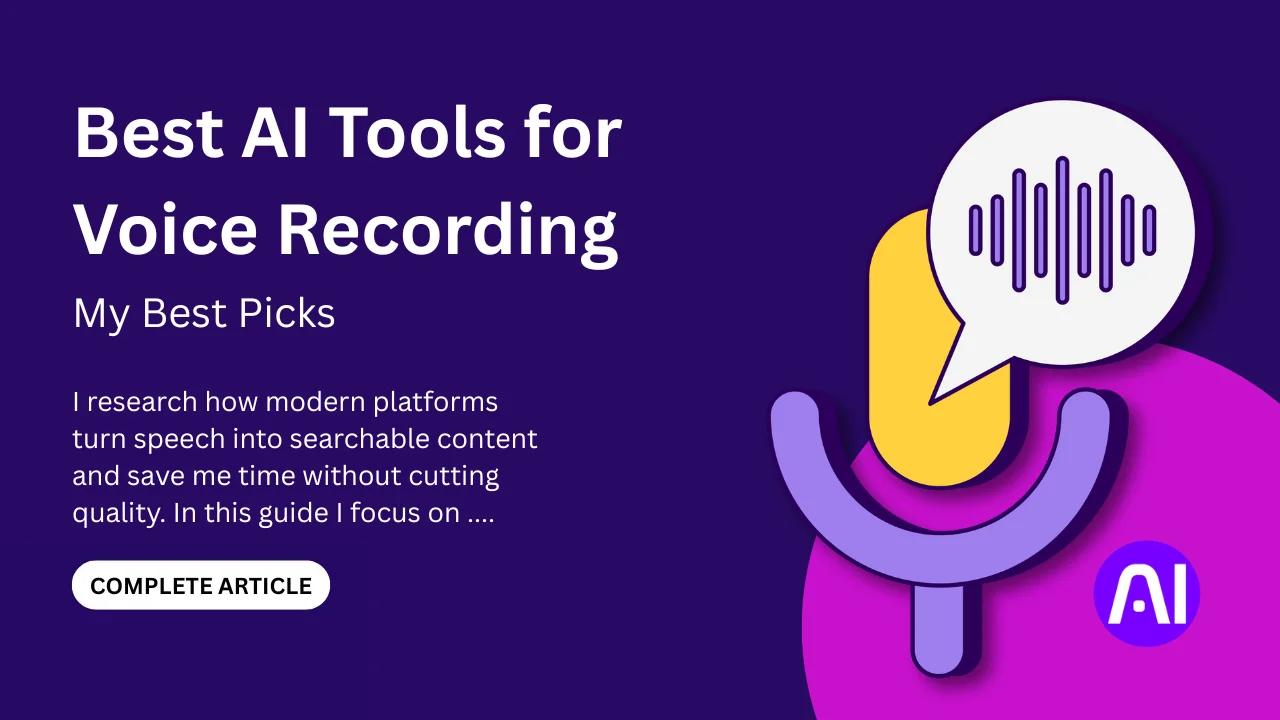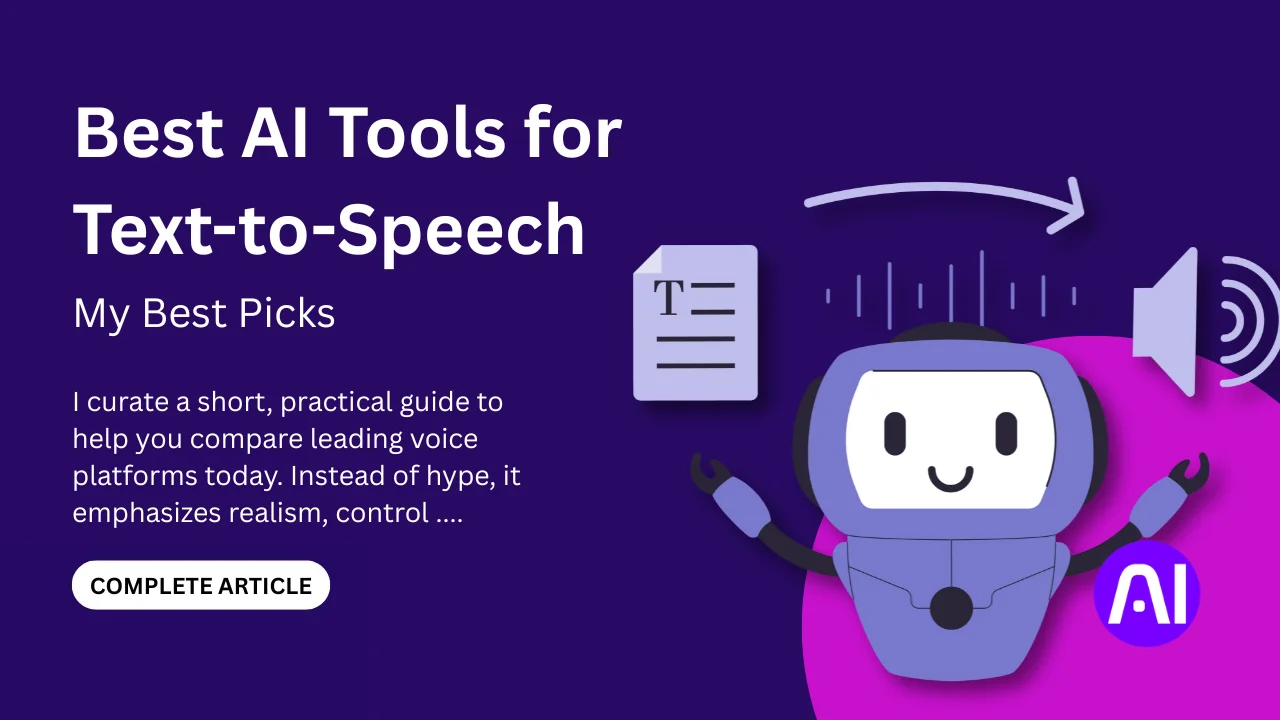Struggling to keep up with assignments, research, and study notes? AI tools for students can completely transform the way you learn and manage your workload. These intelligent tools help you write essays faster, organize notes efficiently, and even create stunning visual projects effortlessly.
By leveraging AI-powered solutions, students save time, boost productivity, and achieve better results without stress. With the right AI tools, every study session becomes smarter and more effective.
Why Students Need AI Tools
Students face numerous challenges in modern academics, from tight deadlines to information overload. Managing multiple subjects and assignments can become overwhelming very quickly. AI tools offer smart solutions to organize tasks and study more effectively. These tools are designed to make learning both efficient and enjoyable.
Academic Challenges Students Face
Many students struggle to keep up with their homework, projects, and exams. Research and writing assignments often take hours without proper guidance. Students also face difficulty in understanding complex concepts quickly. Balancing study and personal life becomes a real challenge.
How AI Tools Address These Challenges
AI tools can automate repetitive tasks, saving students valuable time. They provide summaries, notes, and even writing assistance instantly. Students can focus on understanding concepts rather than conducting manual research. Personalized learning features help students study at their own pace.
Real-Life Examples
AI can transcribe lectures, making notes easier to review later. Writing tools like Grammarly can correct grammar and enhance clarity. AI research assistants efficiently summarize articles and generate references. Even coding assignments can be simplified using AI suggestions.
Categories of AI Tools for Students
AI tools for students come in various forms, each serving a unique purpose. These categories enable students to tackle specific academic challenges more efficiently. From writing and research to productivity and creativity, there’s an AI tool for every need. Understanding these categories will help you select the most suitable tool for your tasks.
Writing & Grammar Assistants
Writing and grammar tools help students create error-free content quickly. They check spelling, grammar, and style while suggesting improvements. These tools save time and improve the quality of essays or assignments. They are essential for academic success in any subject.
Note-Taking & Study Aids
AI note-taking tools help organize information and summarize lessons effectively. Students can create digital flashcards, audio summaries, and interactive study materials to enhance their learning experience. These aids make reviewing faster and more efficient. They are especially helpful during exam preparation or research work.
Research & Academic Assistance
Research tools powered by AI enable students to quickly find, analyze, and summarize information. They reduce the time spent manually searching for reliable sources. These tools also aid in writing research papers and accurately citing references. They improve both speed and accuracy in academic work.
Productivity & Time Management
AI productivity tools assist students in managing tasks, deadlines, and study schedules. They can set reminders, plan projects, and track progress effectively. These tools help ensure that students stay organized and productive on a daily basis. They are a perfect companion for busy academic schedules.
Visual & Creative Tools
Creative AI tools enable students to create visual content for projects and presentations. They can easily generate images, infographics, or design layouts. These tools make learning more engaging and visually appealing. Creativity becomes simpler with AI assistance, even for those without design experience.
Top AI Writing Tools for Students

Writing plays a crucial role in student success, but it can be a challenging task. AI writing tools help improve grammar, clarity, and style quickly and efficiently. Even complex essays become easier to manage with these tools. Choosing the right tool can significantly boost both confidence and productivity.
Grammarly: AI Writing Assistant
Grammarly is a popular AI tool that checks grammar, punctuation, and spelling. It also enhances clarity and suggests better tone and style. Students can use it to quickly improve essays, assignments, and emails. This makes academic writing smoother and more professional.
Features:
- Grammar and spelling correction
- Style and tone suggestions
- Plagiarism detection
- Works with Word, Google Docs, and browsers
Use Case:
Students use Grammarly to proofread essays and research papers efficiently. It saves time and ensures high-quality writing. Large assignments become easier to refine and submit confidently.
QuillBot: Paraphrasing & Summarization
QuillBot is an AI tool that helps paraphrase sentences and summarize long texts. It ensures ideas are expressed clearly while avoiding plagiarism. The tool is ideal for research papers and study notes. Students can complete writing tasks faster and more effectively.
Features:
- Sentence rephrasing
- Summarization of articles and lectures
- Grammar and style improvements
- Citation suggestions
Use Case:
Students rely on QuillBot to summarize research articles efficiently. It saves hours of manual editing while improving clarity. Paraphrasing helps in creating concise notes and essays.
Trinka: Academic Writing Enhancement
Trinka focuses on academic writing by checking grammar, style, and citation compliance. It ensures proper tone for research papers and formal assignments. Students benefit from advanced grammar checks and vocabulary suggestions. The tool is especially useful for university-level writing.
Features:
- Advanced grammar and style corrections
- Citation and reference assistance
- Vocabulary enhancement
- Compliance with academic standards
Use Case:
Students use Trinka to polish research papers and academic assignments. It improves readability and ensures adherence to academic standards. Trinka makes writing formal work much easier and faster.
WriteSonic: AI Content Generation
WriteSonic helps students generate essay drafts, project ideas, and other content quickly. It is perfect for overcoming writer’s block and brainstorming effectively. The tool strikes a balance between creativity and structure, resulting in better writing. Students can complete long or short assignments efficiently.
Features:
- Essay and content generation
- Idea brainstorming assistance
- Grammar and style suggestions
- Multi-language support
Use Case:
Students use WriteSonic to draft essays or outlines efficiently. It saves time while enhancing creativity and structure. The tool works well for both projects and assignments.
Comparison of Writing Tools
| Tool | Overview | Features | Use Case |
| Grammarly | AI tool for grammar, style, and clarity | Grammar, style, plagiarism check | Essays, emails, assignments |
| QuillBot | Paraphrasing and summarization tool | Rephrasing, summarization, grammar | Research papers, study notes |
| Trinka | Academic writing enhancer | Grammar, style, citations | Research papers, high-level reports |
| WriteSonic | AI content and essay generator | Drafts, brainstorming, grammar | Essays, outlines, projects |
AI Note-Taking and Study Tools
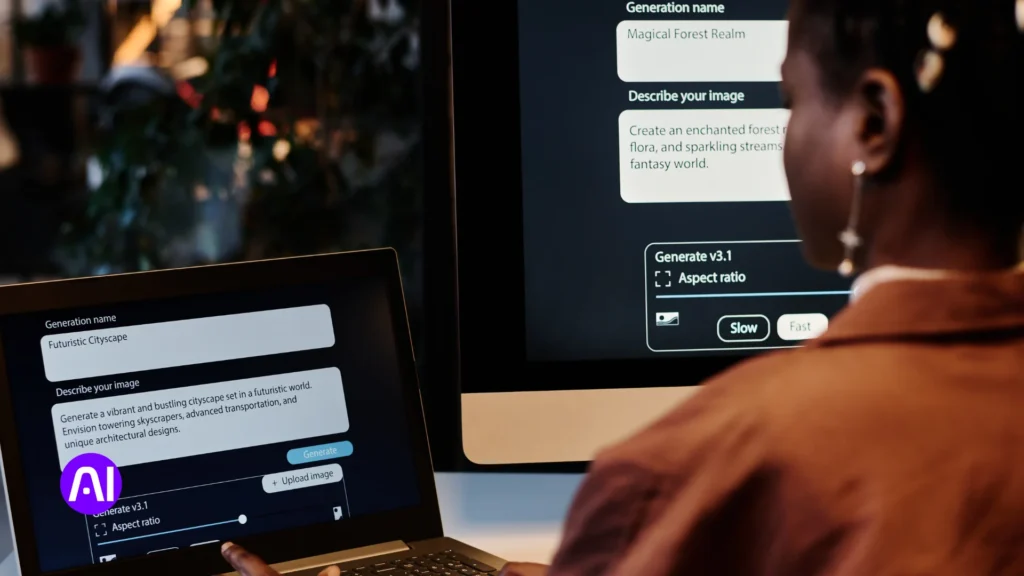
Otter.ai: Real-Time Transcription
Otter.ai is an AI tool that transcribes lectures and meetings in real-time. It allows students to focus on listening rather than writing every word. The tool also highlights speakers and generates searchable transcripts. This makes reviewing notes faster and more organized.
Features:
- Live transcription of lectures and meetings
- Speaker identification
- Searchable and editable transcripts
- Integration with Zoom and other platforms
Use Case:
Students use Otter.ai to accurately capture lecture notes. It saves time and ensures no key points are missed. Reviewing transcripts later becomes easier and more effective.
NotebookLM: AI Study Assistant
NotebookLM is an AI-powered note-taking tool that efficiently organizes study materials. It can summarize content, create flashcards, and generate quizzes for practice. Students benefit from interactive study aids, leading to improved comprehension. This tool simplifies learning complex subjects.
Features:
- AI-generated study notes and summaries
- Flashcards and quizzes
- Audio summaries and highlights
- Organized and searchable notebooks
Use Case:
Students rely on NotebookLM to create structured study notes quickly. It helps retain information through flashcards and quizzes. The tool is especially useful during exam preparation.
NoteGPT: AI Note Generator
NoteGPT assists students by generating concise notes from textbooks or lectures. It condenses important points while maintaining clarity and meaning. The AI helps students study more efficiently and save time. This tool supports both review and learning new topics.
Features:
- Summarizes lectures and textbooks
- Highlights key concepts and definitions
- Generates study guides
- Supports multiple subjects and topics
Use Case:
Students use NoteGPT to create comprehensive notes in minutes. It reduces the time spent manually summarizing content. Perfect for revision and exam preparation.
Mem AI: Smart Memory Aid
Mem AI is an AI tool that organizes knowledge and enhances memory retention. It connects notes, tasks, and ideas in one place. Students can track progress and reinforce learning efficiently. The tool is designed for better knowledge management.
Features:
- Intelligent note linking and organization
- Personalized learning reminders
- Task and study tracking
- Integration with multiple platforms
Use Case:
Students use Mem AI to remember important concepts and deadlines. It helps organize knowledge for long-term retention. Ideal for managing large volumes of study material.
Comparison of Note-Taking Tools
| Tool | Overview | Features | Use Case |
| Otter.ai | Real-time transcription of lectures | Live transcription, speaker ID, searchable notes | Capturing lectures, review notes |
| NotebookLM | AI-generated study notes and summaries | Flashcards, quizzes, audio summaries | Exam preparation, learning new topics |
| NoteGPT | Summarizes lectures and textbooks | Key points, study guides, multi-subject support | Quick note creation, revision |
| Mem AI | Smart knowledge organization | Note linking, reminders, task tracking | Long-term memory, study management |
AI Tools for Research & Academic Writing
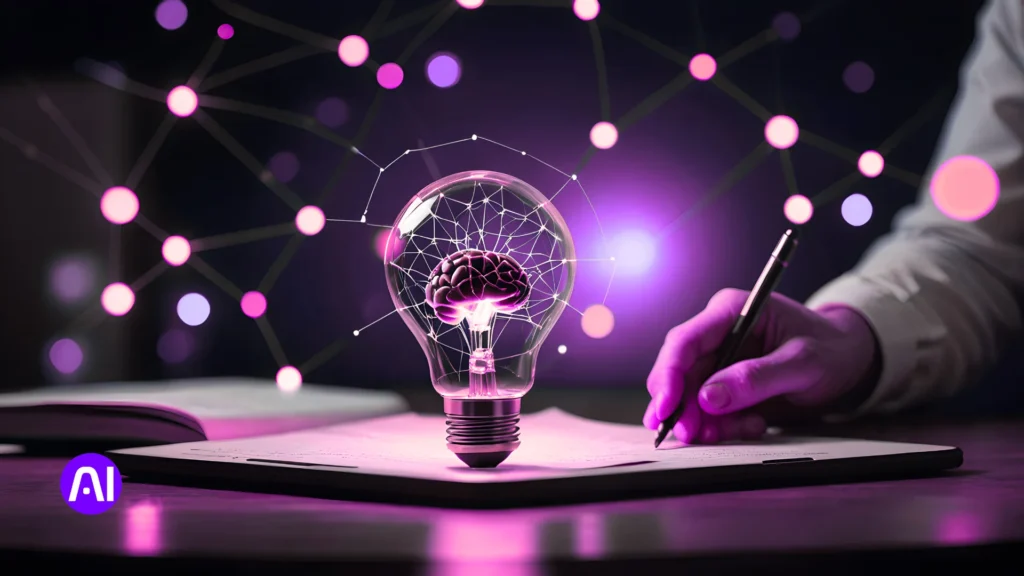
Research is a crucial part of student life, but it can be a time-consuming endeavor. AI tools enable students to quickly find, summarize, and organize information. They improve accuracy and reduce the effort required to complete papers. With AI, students can focus more on analysis and understanding.
Google Gemini: AI Research Assistant
Google Gemini is an AI tool that assists in research by summarizing articles and generating insights. It integrates seamlessly with Google Workspace for ean asy workflow. Students can save hours searching for relevant information. The tool ensures accurate and structured content for assignments.
Features:
- Summarizes research articles
- Generates citations and references
- Integrates with Google Docs and Sheets
- Provides AI-driven insights and suggestions
Use Case:
Students use Google Gemini to quickly gather research materials for assignments. It simplifies referencing and organizes sources efficiently. Ideal for writing research papers or preparing reports.
Perplexity AI: Smart Academic Search
Perplexity AI helps students find and analyze academic papers efficiently. It provides summaries, highlights key points, and ranks sources according to their relevance. This reduces the time spent on manual searches. Students can focus more on understanding the material deeply.
Features:
- Summarizes academic papers and articles
- Highlights important information
- Provides source reliability scores
- Supports multiple disciplines and topics
Use Case:
Students rely on Perplexity AI to streamline literature reviews and assignments. It helps extract key insights quickly and accurately. Perfect for research-heavy projects and studies.
ScholarAI: Academic Paper Analysis
ScholarAI is designed to automatically analyze and organize academic papers. It extracts important data, summarizes content, and assists in note-taking. The AI ensures students spend less time manually reviewing sources. It’s especially useful for complex research tasks.
Features:
- Automated paper analysis and summary
- Highlights key arguments and findings
- Organizes research notes
- Citation and reference suggestions
Use Case:
Students utilize ScholarAI to efficiently analyze multiple research papers. It helps create structured notes and references for writing. Ideal for thesis work and extensive assignments.
Elicit: AI Research Automation
Elicit automates academic research by quickly finding relevant papers and studies. It generates concise summaries and helps organize findings in a logical manner. Students can complete research tasks more efficiently and with greater accuracy. The tool is designed for effective learning and writing.
Features:
- Research paper discovery and summarization
- Key insights extraction
- Organized note generation
- Multi-disciplinary support
Use Case:
Students use Elicit to streamline research for assignments or projects. It saves time and ensures accurate information is collected. Useful for essays, literature reviews, and reports.
Comparison of Research Tools
| Tool | Overview | Features | Use Case |
| Google Gemini | Summarizes articles and provides insights | Summarization, citations, AI insights | Research papers, assignments |
| Perplexity AI | Academic search and summarization | Key points, source ranking, summaries | Literature reviews, projects |
| ScholarAI | Academic paper analysis | Paper summary, notes, citation help | Thesis, research-heavy assignments |
| Elicit | Research automation and note generation | Summarization, insights, note organization | Essays, projects, academic reports |
AI Productivity Tools for Students
Managing tasks, deadlines, and study schedules can be challenging for students. AI productivity tools help organize work, track progress, and boost efficiency. They allow students to focus more on learning rather than planning. These tools are essential for maintaining a productive academic routine.
Notion AI: Task Management & Study Planner
Notion AI is an all-in-one workspace for students to manage tasks, notes, and projects. It helps organize information efficiently and keeps deadlines on track. Students can customize templates to suit their study habits. This tool makes academic planning simple and effective.
Features:
- Task management and project tracking
- AI-assisted note-taking and summaries
- Customizable templates
- Integration with other apps
Use Case:
Students use Notion AI to plan assignments, create study schedules, and manage projects. It keeps all information in one organized space. Ideal for both individual study and group projects.
Mubert: AI-Generated Study Music
Mubert generates AI-powered music designed to improve focus and concentration. It creates an ideal study environment without distractions. Students can customize music based on mood and study requirements. This helps maintain productivity during long study sessions.
Features:
- AI-generated music for focus
- Customizable tracks based on mood or task
- Continuous streaming without interruptions
- Available on multiple platforms
Use Case:
Students use Mubert to enhance concentration during study sessions. It helps maintain focus for longer periods without distractions. Ideal for reading, writing, or revising notes.
Todoist AI: Smart Task Organizer
Todoist AI helps students prioritize and manage tasks efficiently. It uses AI to suggest schedules and deadlines for optimal productivity. Students can track progress and ensure no assignments are missed. The tool simplifies task management for busy academic life.
Features:
- AI-powered task prioritization
- Reminders and deadline suggestions
- Progress tracking
- Integration with calendars and apps
Use Case:
Students use Todoist AI to plan daily tasks and assignments efficiently. It ensures timely completion and reduces stress. Perfect for managing multiple subjects or projects simultaneously.
Google AI Pro: Productivity & Workflow Enhancement
Google AI Pro integrates advanced AI tools across Google Workspace to improve productivity. It assists with document editing, scheduling, and task management. Students can streamline their workflow using AI-powered suggestions. The tool saves time and improves efficiency in academic tasks.
Features:
- AI-assisted document creation and editing
- Smart scheduling and reminders
- Integration with Google Docs, Sheets, and Calendar
- Workflow optimization suggestions
Use Case:
Students use Google AI Pro to manage assignments and deadlines efficiently. It helps organize workflow and improves productivity. Ideal for handling multiple academic tasks at once.
Comparison of Productivity Tools
| Tool | Overview | Features | Use Case |
| Notion AI | Workspace for tasks, notes, and projects | Task management, AI summaries, templates | Study planning, group projects |
| Mubert | AI-generated music for focus | Custom tracks, continuous streaming | Concentration during study sessions |
| Todoist AI | Smart task organizer | Task prioritization, reminders, tracking | Daily task and assignment management |
| Google AI Pro | AI tools integrated with Google apps | Document editing, scheduling, workflow | Assignment management and productivity |
AI Tools for Visual & Creative Projects
Visual and creative projects often require design skills and time, which can be challenging for students. AI tools simplify this by generating images, infographics, and presentations quickly. They help students express ideas visually without advanced design knowledge. Using these tools, creativity becomes easier and more efficient.
DALL·E: AI Image Generation
DALL·E is an AI tool that generates high-quality images from text prompts. Students can create visuals for presentations, projects, or assignments easily. It allows customization to match specific themes or topics. This tool makes visual content creation accessible to everyone.
Features:
- Generates images from text descriptions
- Customizable style and theme
- High-resolution outputs
- Supports multiple formats
Use Case:
Students use DALL·E to create visuals for class projects or presentations. It saves time while enhancing the quality of work. Perfect for design-based assignments without advanced skills.
MidJourney: Creative AI Art
MidJourney helps students create AI-generated art and graphics for creative projects. It uses advanced algorithms to produce visually appealing designs. Students can experiment with different styles and concepts easily. The tool encourages creativity in a simple and engaging way.
Features:
- AI-generated artistic images
- Multiple style options
- High-quality graphics
- User-friendly interface
Use Case:
Students rely on MidJourney to design posters, infographics, or presentation slides. It enhances creativity and saves time on manual design. Ideal for art-related assignments or projects.
Figma Make: AI Design Assistant
Figma Make is an AI-powered tool for designing user interfaces and visual projects. It helps students create prototypes and presentations efficiently. The AI suggests layouts, styles, and components automatically. This tool is perfect for design or tech-related assignments.
Features:
- AI-assisted design suggestions
- Prototype creation
- Layout and style automation
- Collaboration features
Use Case:
Students use Figma Make to design apps, websites, or presentations. It saves time and improves the overall visual quality. Perfect for group projects and tech-related courses.
Canva AI: Creative Design Made Easy
Canva AI streamlines the design of posters, slides, and graphics for students. It provides templates and AI suggestions for professional-quality visuals. Students with minimal design experience can create attractive content quickly. This tool makes visual projects easy and efficient.
Features:
- Ready-made templates
- AI design suggestions
- Graphic and presentation creation
- Drag-and-drop interface
Use Case:
Students use Canva AI to prepare slides, posters, and infographics. It saves time while ensuring visually appealing results. Ideal for presentations, assignments, and creative projects.
Comparison of Visual & Creative Tools
| Tool | Overview | Features | Use Case |
| DALL·E | AI image generator from text | Text-to-image, customizable style, high-resolution | Presentations, project visuals |
| MidJourney | AI creative art generator | Multiple styles, high-quality graphics | Posters, infographics, slides |
| Figma Make | AI design assistant for UI | Layout suggestions, prototypes, and collaboration | App designs, presentations, prototypes |
| Canva AI | AI design tool with templates | Templates, AI suggestions, drag-and-drop | Slides, posters, infographics |
Practical Use Cases of AI Tools for Students
AI tools are not just for convenience; they actively improve learning and productivity. They help students complete tasks more quickly, understand the material better, and organize their work efficiently. By using AI strategically, students can better balance their academic and personal lives. These tools are valuable across multiple aspects of student life.
Essay Writing and Proofreading
AI tools assist in writing essays by suggesting structures, correcting grammar, and improving style. They also help avoid plagiarism while maintaining originality. Students can produce high-quality assignments in less time. This makes essay writing less stressful and more efficient.
Summarizing Lectures and Notes
AI note-taking tools can automatically summarize lectures and organize class notes. This allows students to review material quickly before exams. It also ensures that no key points are missed during study sessions. Summaries can be customized for personal understanding and retention.
Personalized Study Plans & Flashcards
AI can create customized study plans and flashcards based on a student’s learning pace. These tools identify weak areas and suggest focused practice. Students can optimize their study sessions for better results. It makes learning more structured and goal-oriented.
Group Projects & Collaboration Assistance
AI collaboration tools enable students to coordinate and manage group projects more effectively. They can assign tasks, share notes, and track progress in real-time. Communication becomes easier, and deadlines are met efficiently. This significantly enhances teamwork and project quality.
Coding Assignments & Problem Solving
AI programming assistants aid students in writing, debugging, and optimizing code efficiently. They provide suggestions and solutions for complex problems. Students can learn more effectively by avoiding repetitive mistakes. These tools are perfect for coding assignments and software projects.
Summary of Practical Use Cases
| Use Case | AI Tools Used | Benefit |
| Essay Writing & Proofreading | Grammarly, QuillBot, Trinka | Corrects grammar, enhances clarity |
| Summarizing Lectures & Notes | Otter.ai, NotebookLM, NoteGPT | Saves time, organizes information |
| Personalized Study Plans & Flashcards | NotebookLM, Mem AI | Focused learning, better retention |
| Group Projects & Collaboration | Notion AI, Google AI Pro | Efficient teamwork, task tracking |
| Coding Assignments & Problem Solving | WriteSonic, AI coding assistants | Faster learning, error reduction |
Feature Comparison Table
| Category | Tool | Main Features | Best For |
| Writing & Grammar | Grammarly | Grammar, style, plagiarism check | Essays, assignments, emails |
| QuillBot | Paraphrasing, summarization, grammar | Research papers, study notes | |
| Trinka | Grammar, style, citations | Academic papers, reports | |
| WriteSonic | Draft generation, brainstorming, grammar | Long assignments, projects | |
| Note-Taking & Study | Otter.ai | Transcription, searchable notes, speaker ID | Lectures, review notes |
| NotebookLM | Study notes, flashcards, quizzes | Exam prep, comprehension | |
| NoteGPT | Summarizes lectures and textbooks | Quick note creation, revision | |
| Mem AI | Knowledge linking, reminders, tracking | Long-term retention, organization | |
| Research & Academics | Google Gemini | Article summarization, citations, insights | Research papers, reports |
| Perplexity AI | Summarizes papers, highlights key points | Literature reviews, assignments | |
| ScholarAI | Paper analysis, note organization | Thesis, research projects | |
| Elicit | Research automation, note generation | Essays, projects, academic reports | |
| Productivity | Notion AI | Task management, notes, templates | Study planning, group projects |
| Mubert | AI-generated music for focus | Concentration during study | |
| Todoist AI | Task prioritization, reminders, tracking | Daily tasks, assignment management | |
| Google AI Pro | Document editing, scheduling, workflow | Assignment management, productivity | |
| Visual & Creative | DALL·E | Text-to-image, customizable style, high-resolution | Presentations, visuals |
| MidJourney | Artistic AI images, multiple styles | Posters, infographics | |
| Figma Make | Layout suggestions, prototypes, collaboration | Apps, presentations, prototypes | |
| Canva AI | Templates, AI suggestions, drag-and-drop | Slides, posters, infographics |
Best Tools by Category
Writing & Grammar: Grammarly and Trinka are best for assignments and academic papers.
Note-Taking & Study: NotebookLM and Otter.ai are ideal for exam prep and lectures.
Research & Academic Writing: Google Gemini and Elicit help with papers and reports.
Productivity: Notion AI and Todoist AI efficiently manage tasks and schedules.
Visual & Creative: DALL·E and Canva AI simplify the design of visuals and presentations.
This comparison helps students select the most suitable tools for their specific needs. Choosing the right AI tool reduces study time while improving quality. It ensures tasks are completed efficiently and effectively.
Tips for Using AI Tools Effectively
AI tools can significantly enhance learning, but using them effectively is crucial. Students should integrate AI into their workflow without losing critical thinking. Proper strategies ensure maximum benefits while maintaining academic integrity. These tips help students use AI tools efficiently and responsibly.
Start with Free Versions
Students should start with free versions of AI tools to familiarize themselves with their features. This allows them to explore functionality without incurring financial commitments. Once comfortable, premium versions can be considered for advanced features. Gradual adoption ensures smarter and cost-effective usage.
Verify AI Outputs
Always verify the accuracy and relevance of AI-generated content. AI can make mistakes or provide incomplete information. Cross-referencing with credible sources ensures reliability. This practice helps maintain the quality and accuracy of assignments.
Balance AI with Manual Learning
AI should complement, not replace, traditional learning methods. Students should practice critical thinking and problem-solving independently. Using AI alongside manual study ensures deeper understanding. Balanced usage improves both efficiency and knowledge retention.
Customize Tools for Personal Needs
Many AI tools allow personalization, like study schedules or content style. Students should adjust settings according to learning preferences. Customized tools increase productivity and engagement. Personalization ensures AI aligns with individual academic goals.
Maintain Ethical Practices
Students must use AI responsibly to avoid plagiarism or academic misconduct. Proper citation and acknowledgment are essential when using AI-generated content. Ethical usage promotes integrity and avoids penalties. Responsible practice ensures AI is a learning aid, not a shortcut.
Conclusion
AI tools are revolutionizing the way students learn, study, and create. They simplify tasks like writing, research, note-taking, productivity, and creative projects. By utilizing AI strategically, students can save time, enhance efficiency, and achieve better academic outcomes. These tools enhance learning while making study routines more manageable and engaging.
Students must strike a balance between AI assistance and manual learning to develop critical thinking and a deeper understanding. Responsible usage ensures academic integrity, accurate information, and ethical practices. By exploring the right tools for writing, research, productivity, and creativity, students can maximize their potential.
FAQs
1. What are AI tools for students?
AI tools for students are software programs that use artificial intelligence to help with writing, studying, organising notes, and doing research.
2. How do AI tools save me time with assignments?
They can summarise ideas, check grammar, suggest content, or organise your notes so you spend less time doing the manual tasks.
3. Can AI tools replace studying?
No, AI tools help you work smarter, but you still need to study, understand concepts, and think for yourself.
4. Are AI tools safe and reliable for schoolwork?
Most are safe, but you should check the tool’s terms, verify outputs, and never use them to cheat. Always review what they produce.
5. How do I pick the right AI tool for my need?
Think what you need writing help, note-taking, research or creativity and choose a tool that matches that category. Try free versions first.
6. Can AI tools help me organise my study schedule?
Yes, many AI tools include task planners or reminders so you can keep track of deadlines, manage subjects and stay organised.
7. Do I need to know how to code or tech-savvy to use these tools?
Not always. Many AI tools are built for students and use simple interfaces so you don’t need to be a tech expert.
8. Does using AI tools count as cheating?
It depends how you use them. If you rely on them but still write in your own words, understand the work and cite where needed, then it’s fine. If you submit the tool’s output as your own without change, it may be considered cheating.
9. Will AI tools understand my subject (science, history, languages)?
Most AI tools are quite broad and can work for different subjects, but some may be better in one area than another. Always check the output fits your subject.
10. How do I make the most of AI tools for my study?
Use them to brainstorm, summarise, organise and check your work. Then review and improve the result with your own thinking and voice.

